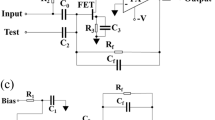Abstract
The readout noise for Charge-Coupled Devices (CCDs) has been the main limitation when using these detectors for measuring small amplitude signals. A scientific CCD fabricated on a high-resistivity silicon substrate utilizing a floating gate amplifier with the capability of multiple sampling of the charge signal is described in this paper. The Skipper CCD architecture and its advantages for low noise applications are discussed. A technique for obtaining sub-electron readout noise levels is presented, and its noise and signal characteristics are derived. We demonstrate that with this procedure a very low readout noise of 0.2e − RMS can be achieved. The contribution of other noise sources (output stage, vertical and horizontal charge transfer inefficiency, and dark current noise) are also considered. The optimum number of samples for achieving the total lowest possible noise level is obtained. This technique is applied to an X-rays experiment using a 55Fe source.
















Similar content being viewed by others
References
Boyle, W.S.: Nobel lecture: CCD—an extension of man’s view. Rev. Mod. Phys. 82(3), 2305–2306 (2010)
Smith, G.E.: Nobel lecture: the invention and early history of the CCD. Rev. Mod. Phys. 82 (3), 2307–2312 (2010)
Flaugher, B.: The dark energy survey instrument design. In: McLean, I.S., Iye, M. (eds.) Ground-based and Airborne Instrumentation for Astronomy. Proceedings of the SPIE, vol. 6269 (2006)
McLean, I.: Electronic Imaging in Astronomy—Detectors and Instrumentation, 2nd edn. Springer-Praxis, Berlin (2008)
Janesick, J.R.: Scientific Charge Coupled Devices. SPIE Publications, Bellingham, Washington (2001)
Chandler, C.E., et al.: Sub-electron noise charge coupled devices. SPIE Charge-Coupled Devices and Solid State Optical Sens. 1242, 238–251 (1990)
Janesick, J.R., et al.: New advancements in charge-coupled device technology: sub-electron noise and 4096×4096 pixel CCDs. SPIE Charge-Coupled Devices and Solid StateOptical Sens. 1242, 223–237 (1990)
Holland, S.E., et al.: Fully depleted, back-illuminated charge-coupled devices fabricated on high-resistivity silicon. IEEE Trans. Electron. Dev. 50(1), 225–238 (2003)
Wen, D.D.: Design and operation of a floating gate amplifier. J. Solid-State Circuits SC-9(6), 410–414 (1974)
Hynecek, J.: Low noise and high-speed charge detection in high-resolution CCD image sensors. IEEE Trans. Electron. Dev. 44(10), 1679–1688 (1997)
Honscheid, K., DePoy, D.L.: The dark energy camera (DECam)-a new instrument for the dark energy survey. In: IEEE Nuclear Science Symposium Conference Record NSS ’08, pp. 3357–3360 (2008)
Kandiah, K., Whiting, F.B.: Low noise charge sensing at the output of a CCD. IEE CCD workshop (1991)
Kandiah, K., Whiting, F.B.: Limits of resolution of charge sensitive detector systems. Nucl. Instrum. Methods Phys. Res. A 326(1–2), 49–62 (1993). ISSN 0168-9002. doi:10.1016/0168-9002(93)90332-C
Estrada, J., et al.: Focal plane detectors for Dark Energy Camera (DECam). In: Proc. SPIE, vol. 7735, p. 77351R (2010)
Diehl, H.T., et al.: Characterization of DECam focal plane detectors. In: Dorn, D.A., Holland, D. (eds.) High Energy, Optical and Infrared Detectors for Astronomy III, Proceedings of the SPIE, vol. 7021, p. 70217 (2008)
Estrada, J., et al.: CCD testing and characterization for dark energy survey. In: McLean, I.S., Iye, M. (eds.) Ground-based and Airborne Instrumentation for Astronomy, Proceedings of the SPIE, vol. 6269, p. 62693K (2006)
Owens, A., Fraser, G.W., McCarthy, K.J.: On the experimental determination of the Fano factor in Si at soft X-ray wavelengths. Nucl. Instrum. Methods Phys. Res. A 491(3), 437–443
Fraser,G.W., et al.: The X-ray energy response of silicon Part A. Theory. Nucl. Instrum. Methods Phys. Res. A 350(1–2), 368–378
Janesick, J., et al.: Fano-noise limited CCDs. Proc. SPIE, vol. 982, p. 70 (1988)
Estrada, J., et al.: Prospects for a direct dark matter search using high resistivity CCD detectors. arXiv:0802.2872v3 [hep-ex] (2008). Accessed 1 Jul 2008
Barreto, J., et al.: Direct Search for Low Mass Dark Matter Particles with CCDs. arXiv:1105.5191v2 (2011)
Author information
Authors and Affiliations
Corresponding author
Rights and permissions
About this article
Cite this article
Fernández Moroni, G., Estrada, J., Cancelo, G. et al. Sub-electron readout noise in a Skipper CCD fabricated on high resistivity silicon. Exp Astron 34, 43–64 (2012). https://doi.org/10.1007/s10686-012-9298-x
Received:
Accepted:
Published:
Issue Date:
DOI: https://doi.org/10.1007/s10686-012-9298-x




